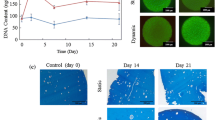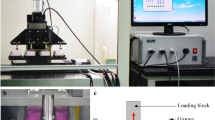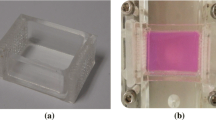Abstract
Dynamic mechanical stimulation has been an effective method to improve the growth of tissue engineering cartilage constructs derived from immature cells. However, when more mature cell populations are used, results are often variable due to the differing responses of these cells to external stimuli. This can be especially detrimental in the case of mechanical loading. In previous studies, multi-modal mechanical stimulation in the form of stochastic resonance was shown to be effective at improving the growth of young bovine chondrocytes. Thus, the aim of this study was to investigate the short-term and long-term effects of stochastic resonance on two groups of bovine chondrocytes, adult (> 30 month) and juvenile (~ 18 months). While the juvenile cells outperformed the adult cells in terms of their anabolic response to loading, combined mechanical loading for both age groups resulted in greater matrix synthesis compared to compressive loading alone. In the adult cells, potential pathological tissue formation was evident with the presence of cell clustering. However, the presence of broad-band mechanical vibrations (alone or with compressive loading) appeared to mitigate this response and allow these cells to attain a growth response similar to the juvenile, unstimulated cells. Therefore, the use of stochastic resonance appears to show promise as a method to improve the formation and properties of tissue engineered cartilage constructs, irrespective of cell age.






Similar content being viewed by others
References
Akizuki, S., V. C. Mow, F. Müller, J. C. Pita, D. S. Howell, and D. H. Manicourt. Tensile properties of human knee joint cartilage: I. Influence of ionic conditions, weight bearing, and fibrillation on the tensile modulus. J. Orthop. Res. 4:379–392, 1986.
Alexopoulos, L. G., I. Youn, P. Bonaldo, and F. Guilak. Developmental and osteoarthritic changes in Col6a1-knockout mice: biomechanics of type VI collagen in the cartilage pericellular matrix. Arthritis Rheum. 60:771–779, 2009.
Arikawa-Hirasawa, E., W. R. Wilcox, and Y. Yamada. Dyssegmental dysplasia, Silverman–Handmaker type: unexpected role of perlecan in cartilage development. Am. J. Med. Genet. 106:254–257, 2001.
Barbero, A., S. Grogan, D. Schäfer, M. Heberer, P. Mainil-Varlet, and I. Martin. Age related changes in human articular chondrocyte yield, proliferation and post-expansion chondrogenic capacity. Osteoarthr. Cartil. 12:476–484, 2004.
Bloch-Salisbury, E., P. Indic, F. Bednarek, and D. Paydarfar. Stabilizing immature breathing patterns of preterm infants using stochastic mechanosensory stimulation. J. Appl. Physiol. 107:1017–1027, 2009.
Brady, M. A., S. D. Waldman, and C. R. Ethier. The application of multiple biophysical cues to engineer functional neo-cartilage for treatment of osteoarthritis (part I: cellular response). Tissue Eng. Part B Rev. 21:1–19, 2015.
Brandt, K., M. Doherty, and L. Lohmander. Composition and structure of articular cartilage. In: Osteoarthritis, edited by K. Brandt, M. Doherty, and L. Lohmander. New York: Oxford University Press, 1998, pp. 110–111.
Brighton, C. T., W. Wang, and C. C. Clark. The effect of electrical fields on gene and protein expression in human osteoarthritic cartilage explants. J. Bone Jt. Surg. Am. 90:833–848, 2008.
Buschmann, M. D., Y. A. Gluzband, A. J. Grodzinsky, J. H. Kimura, and E. B. Hunziker. Chondrocytes in agarose culture synthesize a mechanically functional extracellular matrix. J. Orthop. Res. 10:745–758, 1992.
Byers, B. A., R. L. Mauck, I. E. Chiang, and R. S. Tuan. Transient exposure to transforming growth factor beta 3 under serum-free conditions enhances the biomechanical and biochemical maturation of tissue-engineered cartilage. Tissue Eng. Part A 14:1821–1834, 2008.
Carter, D. R., G. S. Beaupre, M. Wong, R. L. Smith, T. P. Andriacchi, and D. J. Schurman. The mechanobiology of articular cartilage development and degeneration. Clin. Orthop. Relat. Res. 427:S69–S77, 2004.
Castillo, A. B., I. Alam, S. M. Tanaka, J. Levenda, J. Li, S. J. Warden, and C. H. Turner. Low-amplitude, broad-frequency vibration effects on cortical bone formation in mice. Bone 39:1087–1096, 2006.
Caterson, B., and D. A. Lowther. Changes in the metabolism of the proteoglycans from sheep articular cartilage in response to mechanical stress. Biochim. Biophys. Acta Gen. Subj. 540:412–422, 1978.
Fan, J. C. Y., and S. D. Waldman. The effect of intermittent static biaxial tensile strains on tissue engineered cartilage. Ann. Biomed. Eng. 38:1672–1682, 2010.
Farnsworth, N. L., L. R. Antunez, and S. J. Bryant. Dynamic compressive loading differentially regulates chondrocyte anabolic and catabolic activity with age. Biotechnol. Bioeng. 110:2046–2057, 2013.
Forsyth, C. B., A. Cole, G. Murphy, J. L. Bienias, H.-J. Im, and R. F. Loeser. Increased matrix metalloproteinase-13 production with aging by human articular chondrocytes in response to catabolic stimuli. J. Gerontol. Ser. A Biol. Sci. Med. Sci. 60:1118–1124, 2005.
Hung, C. T., R. L. Mauck, C. C.-B. Wang, E. G. Lima, and G. A. Ateshian. A paradigm for functional tissue engineering of articular cartilage via applied physiologic deformational loading. Ann. Biomed. Eng. 32:35–49, 2004.
Kaupp, J. A., and S. D. Waldman. Mechanical vibrations increase the proliferation of articular chondrocytes in high-density culture. Proc. Inst. Mech. Eng. Part H 222:695–703, 2008.
Kaupp, J. A., J. F. Weber, and S. D. Waldman. Mechanical stimulation of chondrocyte-agarose hydrogels. J. Vis. Exp. 2012. https://doi.org/10.3791/4229.
Keene, D. R., E. Engvall, and R. W. Glanville. Ultrastructure of type VI collagen in human skin and cartilage suggests an anchoring function for this filamentous network. J. Cell Biol. 107:1995–2006, 1988.
Kiviranta, I., J. Jurvelin, M. Tammi, A.-M. SääMäunen, and H. J. Helminen. Weight bearing controls glycosaminoglycan concentration and articular cartilage thickness in the knee joints of young beagle dogs. Arthritis Rheum 30:801–809, 1987.
Knudson, C. B., and W. Knudson. Cartilage proteoglycans. Semin. Cell Dev. Biol. 12:69–78, 2001.
Lee, D. A., and M. M. Knight. Mechanical loading of chondrocytes embedded in 3D constructs: in vitro methods for assessment of morphological and metabolic response to compressive strain. Methods Mol. Med. 100:307–324, 2004.
Leung, M. K., L. I. Fessler, D. B. Greenberg, and J. H. Fessler. Separate amino and carboxyl procollagen peptidases in chick embryo tendon. J. Biol. Chem. 254:224–232, 1979.
Martin, J. A., S. M. Ellerbroek, and J. A. Buckwalter. Age-related decline in chondrocyte response to insulin-like growth factor-I: the role of growth factor binding proteins. J. Orthop. Res. 15:491–498, 1997.
Mauck, R. L., and M. A. Soltz. Functional tissue engineering of articular cartilage through dynamic loading of chondrocyte-seeded agarose gels. J. Biomed. Eng. 122:252–260, 2000.
Mesa, J. M., V. Zaporojan, C. Weinand, T. S. Johnson, L. Bonassar, M. A. Randolph, M. J. Yaremchuk, and P. E. Butler. Tissue engineering cartilage with aged articular chondrocytes in vivo. Plast. Reconstr. Surg. 118:41–49, 2006.
Ongaro, A., A. Pellati, F. F. Masieri, A. Caruso, S. Setti, R. Cadossi, R. Biscione, L. Massari, M. Fini, and M. De Mattei. Chondroprotective effects of pulsed electromagnetic fields on human cartilage explants. Bioelectromagnetics 32:543–551, 2011.
Quinn, T. M., P. Schmid, E. B. Hunziker, and A. J. Grodzinsky. Proteoglycan deposition around chondrocytes in agarose culture: construction of a physical and biological interface for mechanotransduction in cartilage. Amsterdam: IOS Press, 2002.
Söder, S., L. Hambach, R. Lissner, T. Kirchner, and T. Aigner. Ultrastructural localization of type VI collagen in normal adult and osteoarthritic human articular cartilage. Osteoarthr. Cartil. 10:464–470, 2002.
Tanaka, S. M., J. Li, R. L. Duncan, H. Yokota, D. B. Burr, and C. H. Turner. Effects of broad frequency vibration on cultured osteoblasts. J. Biomech. 36:73–80, 2003.
Thonar, E., L. Lohmander, J. Kimura, S. Fellini, M. Yanagishita, and V. Hascall. Biosynthesis of O-linked oligosaccharides on proteoglycans by chondrocytes from the swarm rat chondrosarcoma. J. Biol. Chem. 258:11564–11570, 1983.
Tran-Khanh, N., C. D. Hoemann, M. D. McKee, J. E. Henderson, and M. D. Buschmann. Aged bovine chondrocytes display a diminished capacity to produce a collagen-rich, mechanically functional cartilage extracellular matrix. J. Orthop. Res. 23:1354–1362, 2005.
Waldman, S., and D. Couto. Multi-axial mechanical stimulation of tissue engineered cartilage: review. Eur. Cell. Mater. 13:66–73, 2007.
Waldman, S. D., C. G. Spiteri, M. D. Grynpas, R. M. Pilliar, and R. A. Kandel. Long-term intermittent compressive stimulation improves the composition and mechanical properties of tissue-engineered cartilage. Tissue Eng. 10:1323–1331, 2004.
Weber, J. F., and S. D. Waldman. Calcium signaling as a novel method to optimize the biosynthetic response of chondrocytes to dynamic mechanical loading. Biomech. Model. Mechanobiol. 13:1387–1397, 2014.
Weber, J. F., and S. D. Waldman. Stochastic resonance is a method to improve the biosynthetic response of chondrocytes to mechanical stimulation. J. Orthop. Res. 34:231–239, 2016.
Wernike, E., Z. Li, M. Alini, and S. Grad. Effect of reduced oxygen tension and long-term mechanical stimulation on chondrocyte-polymer constructs. Cell Tissue Res. 331:473–483, 2008.
Wilusz, R. E., L. E. DeFrate, and F. Guilak. A biomechanical role for perlecan in the pericellular matrix of articular cartilage. Matrix Biol. 31:320–327, 2012.
Acknowledgments
Funding for this work was provided by the Natural Sciences and Engineering Research Council (NSERC) of Canada.
Conflict of interest
None.
Author information
Authors and Affiliations
Corresponding author
Additional information
Associate Editor Peter E. McHugh oversaw the review of this article.
Electronic supplementary material
Below is the link to the electronic supplementary material.
Rights and permissions
About this article
Cite this article
Weber, J.F., Chiu, L.L., Balko, S. et al. Stochastic Resonance with Dynamic Compression Improves the Growth of Adult Chondrocytes in Agarose Gel Constructs. Ann Biomed Eng 47, 243–256 (2019). https://doi.org/10.1007/s10439-018-02123-x
Received:
Accepted:
Published:
Issue Date:
DOI: https://doi.org/10.1007/s10439-018-02123-x




